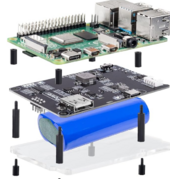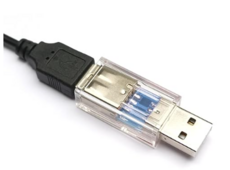lboucher26
New Member
- Joined
- Sep 24, 2022
- Messages
- 59
Hi All
Figured i would just post my story, as it might help someone.
So i had Solar Assistant setup on an Orange PI, for a bit over a year.
It was running from an SD card.
Then it suddenly failed.
At first i thought it was the SD card, but after lots of troubleshooting, i think the card was fine... I think the board just failed...
I cannot get it to start with multiple fresh and reformatted SD cards... Just no LEDs at all regardless of what Power supply i use...
So i setup an old Raspberry Pi3B in its stead.
And got a Solid State USB SSD setup.
Started experimenting.
I was using a power supply like this:

So that it was powered direct from the solar battery bank.
Unfortunately, this device is providing like 4.9 VDC, and does dip to like 4.7
Which is evidently enough to make the PI throttle as shown by this command.
vcgencmd get_throttled
Which is kinda annoying because it was drawing less than half an amp... As measured with one of these.

I could get it to run unthrottled by using my best phone charger which output 5.1 VDC
I decided to try a Sunfounder USB UPS.

Unfortunately... No dice, if i plug in the power supply from the solar batteries the output voltage drops to 4.9
Unplugged it does output 5.1 and the pi starts as desired.
I'm probably going to power it from Mains with the UPS and call it a day.
SEPERATE ISSUE, in same saga....
When i changed from a SD Card to a USB SSD.
Suddenly i realized that IF my EG4 6000 inverter was plugged into the Raspberry PI and i applied power to the pi... I just would not start.
If i unplugged the inverter, it would start.
I also have my LifePower batteries plugged in via USB RS485 adapter. That doesn't seem to affect the PI at all.
I did notice that it seemed like power was flowing from the Inverter to the PI via that USB connection... So i was wondering if that was causing an issue on boot.
I did get a USB power blocker

That appears to have had no effect.
Working with ChatGPT.
I updated the PI using these commands
sudo apt update
sudo apt full-upgrade
sudo rpi-update
No effect
I added usb-storage.quirks=0dd8:0562:u to the boot command line.
Trying to force it to use the right USB device to boot.
No effect...
And to clarify, the PI will not recover from a full shutdown and power cycle NOR via a reboot if the Inverter is plugged in.
Only other idea i have is to hookup the inverter data line to a relay... Which seems ridiculous...
Ohh and yes, if i power up the PI, with the good cell charger connected, let it boot happy, no throttling, then switch to Solar Power VDC to USB charger, it then throttles.
Any ideas or thoughts on this whole debacle are welcome.
Figured i would just post my story, as it might help someone.
So i had Solar Assistant setup on an Orange PI, for a bit over a year.
It was running from an SD card.
Then it suddenly failed.
At first i thought it was the SD card, but after lots of troubleshooting, i think the card was fine... I think the board just failed...
I cannot get it to start with multiple fresh and reformatted SD cards... Just no LEDs at all regardless of what Power supply i use...
So i setup an old Raspberry Pi3B in its stead.
And got a Solid State USB SSD setup.
Started experimenting.
I was using a power supply like this:

So that it was powered direct from the solar battery bank.
Unfortunately, this device is providing like 4.9 VDC, and does dip to like 4.7
Which is evidently enough to make the PI throttle as shown by this command.
vcgencmd get_throttled
Which is kinda annoying because it was drawing less than half an amp... As measured with one of these.

I could get it to run unthrottled by using my best phone charger which output 5.1 VDC
I decided to try a Sunfounder USB UPS.

Unfortunately... No dice, if i plug in the power supply from the solar batteries the output voltage drops to 4.9
Unplugged it does output 5.1 and the pi starts as desired.
I'm probably going to power it from Mains with the UPS and call it a day.
SEPERATE ISSUE, in same saga....
When i changed from a SD Card to a USB SSD.
Suddenly i realized that IF my EG4 6000 inverter was plugged into the Raspberry PI and i applied power to the pi... I just would not start.
If i unplugged the inverter, it would start.
I also have my LifePower batteries plugged in via USB RS485 adapter. That doesn't seem to affect the PI at all.
I did notice that it seemed like power was flowing from the Inverter to the PI via that USB connection... So i was wondering if that was causing an issue on boot.
I did get a USB power blocker

That appears to have had no effect.
Working with ChatGPT.
I updated the PI using these commands
sudo apt update
sudo apt full-upgrade
sudo rpi-update
No effect
I added usb-storage.quirks=0dd8:0562:u to the boot command line.
Trying to force it to use the right USB device to boot.
No effect...
And to clarify, the PI will not recover from a full shutdown and power cycle NOR via a reboot if the Inverter is plugged in.
Only other idea i have is to hookup the inverter data line to a relay... Which seems ridiculous...
Ohh and yes, if i power up the PI, with the good cell charger connected, let it boot happy, no throttling, then switch to Solar Power VDC to USB charger, it then throttles.
Any ideas or thoughts on this whole debacle are welcome.



